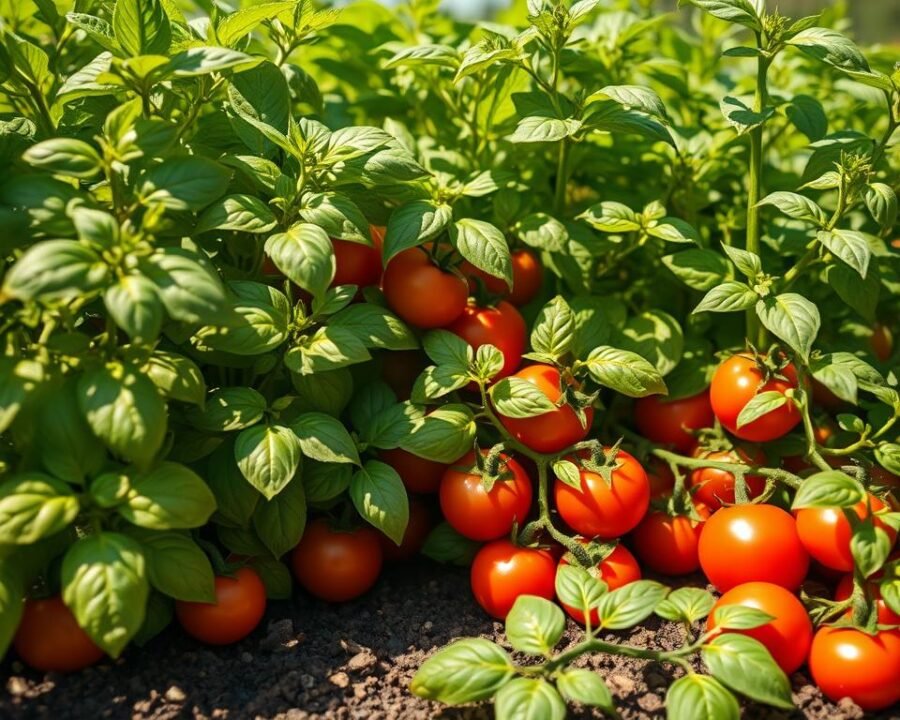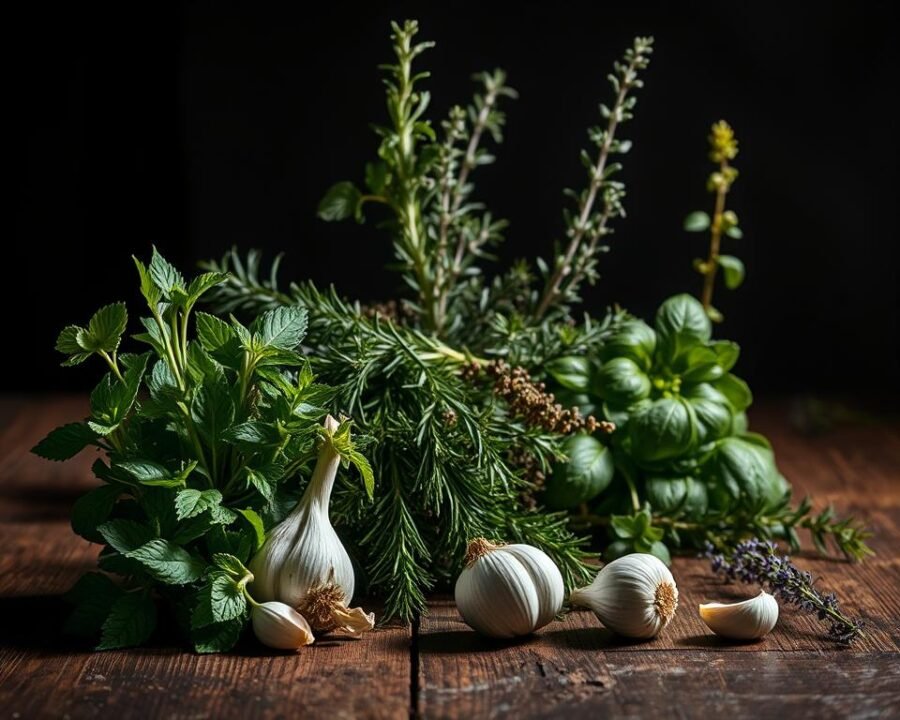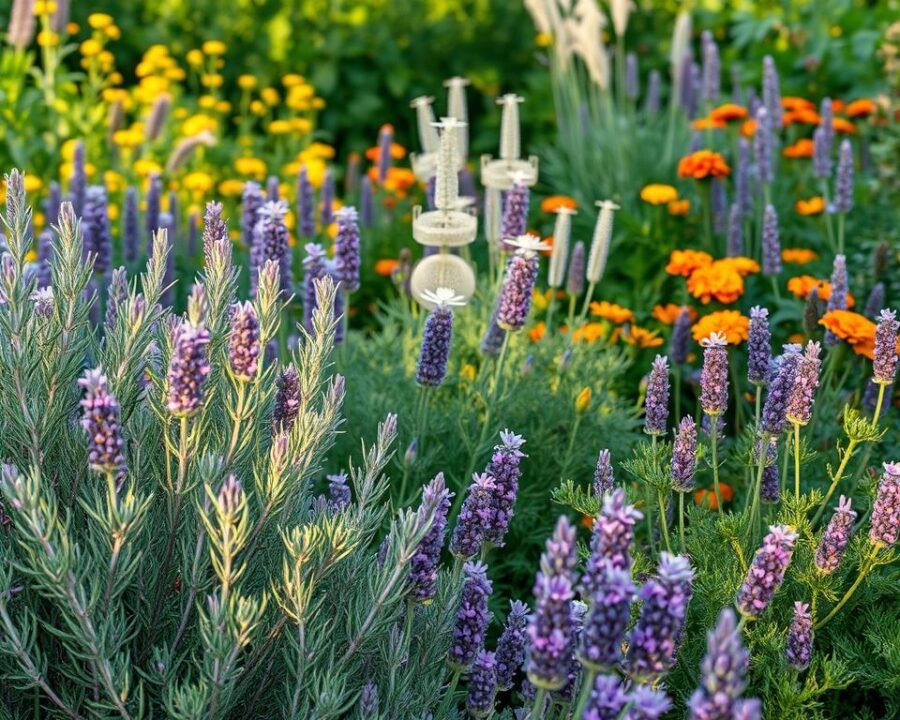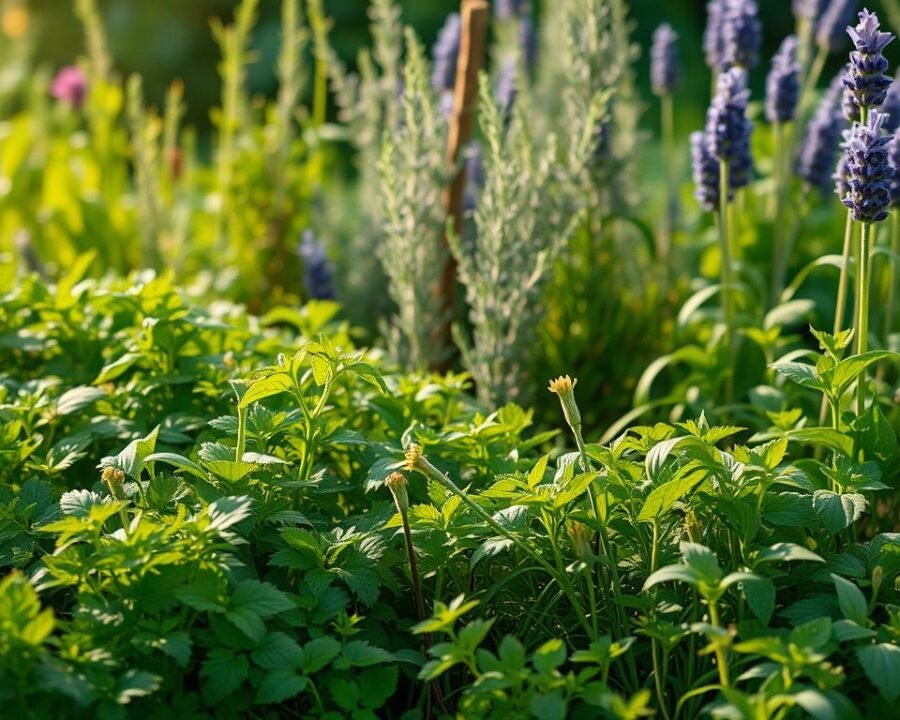We Share How to Grow Herb Companion Planting Everyone Is Using
Gardening brings joy, and pairing the right plants together can make it even better. Imagine fresh basil next to juicy tomatoes or fragrant rosemary beside hardy sage. These combinations don’t just look good—they boost growth and keep pests away naturally.
In 2024, smart gardeners are turning to this method for bigger harvests and tastier flavors. We tested these pairings in real gardens, and the results speak for themselves. Whether you’re a beginner or a seasoned grower, these tips will help your garden thrive.
Key Takeaways
- Pairing herbs improves growth and deters pests naturally.
- Popular combos like basil and tomatoes enhance flavor.
- This method saves space while increasing yields.
- Tested in real gardens for reliable results.
- Perfect for both new and experienced gardeners.
Why Companion Planting with Herbs Is a Game-Changer
Nature has its own way of helping plants thrive when placed together strategically. This method, called companion planting, turns your garden into a teamwork powerhouse. Herbs don’t just add flavor—they protect, nourish, and even improve the taste of their neighbors.
The Science Behind Companion Planting
Some herbs, like basil, release chemicals that boost growth. This process, called allelopathy, helps nearby plants absorb more nutrients. For example, basil’s roots secrete compounds that repel whiteflies while enhancing tomato flavor.
Other partnerships, like beans and rosemary, fix nitrogen in the soil. This natural fertilizer helps plants grow well together without synthetic additives. USDA studies show plots using these pairs yield 40% more than solo plantings.
Benefits for Your Garden and Kitchen
Companion planting saves space and time. Tall herbs like dill shade low-growing thyme, maximizing every inch. Chives deter aphids from carrots, reducing the need for sprays.
In the kitchen, these pairs shine. Basil deepens tomato sweetness, while rosemary elevates roasted veggies. It’s a win-win: fewer pests, richer flavors, and happier plants.
How to Grow Herb Companion Planting Everyone Is Using
Smart gardeners know success starts with the right foundation—location and timing. Get these elements right, and your plants will thrive with minimal effort. Let’s break down the essentials.
Soil: The Hidden Hero
Not all herbs love the same soil. Lavender thrives in alkaline, sandy beds, while parsley prefers slightly acidic loam. Mediterranean herbs like rosemary demand sharp drainage, but basil craves rich, moist earth.
Test your soil’s pH before planting. A simple kit from your local nursery can save months of guesswork. For mint, use containers—it spreads aggressively and can overpower neighbors.
Sunlight: A Delicate Balance
Basil soaks up 6+ hours of direct sun, but lemon balm wilts in the same spot. Map your garden’s light patterns through the day. South-facing areas get the most intensity, while north corners offer gentle shade.
“Herbs tell you what they need—yellow leaves scream for less sun, leggy stems beg for more.”
Timing Is Everything
Plant dill two weeks before tomatoes to lure pests away. Stagger planting by USDA zone for nonstop harvests. In cooler zones, start thyme indoors 8 weeks before the last frost.
Fast-growers like cilantro fit between slow thyme. Oregano doubles as living mulch, locking in moisture. With these hacks, your garden will grow well all season.
Best Herb Combinations for a Thriving Garden
Certain herbs create magic when paired together. They boost growth, repel pests, and even improve flavor. Here are the top companion plants that make gardens flourish.

Basil and Its Perfect Partners
Basil is a superstar in the garden. When planted near tomatoes, it repels whiteflies and enhances their sweetness. Peppers thrive alongside it too, thanks to basil’s pest-deterring oils.
Marigolds add extra protection, creating a vibrant, pest-free zone. For a powerful trio, pair basil with oregano and parsley. Studies show this combo increases essential oil content by 25%.
Rosemary and Sage: A Dynamic Duo
Rosemary and sage form a protective barrier. Their strong scents confuse pests, keeping beans and carrots safe. Research reveals this pairing cuts beetle infestations by 30%.
Plant them near tender lettuces for natural wind protection. Thyme and parsley also thrive in their company, creating a hardy, fragrant corner. For more tips, check this herb pairing guide.
Mint and Its Surprising Allies
Mint boosts pea yields by 15% but needs containment. Bury pots to control its spread while benefiting neighbors. Peas and tomatoes grow stronger near mint’s pest-repelling leaves.
For cabbage patches, lavender borders work wonders. Their scent deters moths without chemicals. Eggplant lovers should try tarragon—it enhances both growth and taste.
- Basil + tomatoes = sweeter fruit, fewer pests
- Rosemary + beans = natural beetle defense
- Mint + peas = higher yields in contained spaces
- Lavender edges = cabbage protection
- Tarragon + eggplant = flavor and growth boost
Herbs That Should Never Be Planted Together
Not all herbs play nice—some actually harm each other when grown side by side. While many herbs together boost yields, others release toxins or compete ruthlessly for resources. Knowing which pairs clash saves time, space, and heartache.

Incompatible Pairs and Why They Clash
Fennel is the garden’s loner. Its roots secrete chemicals that inhibit most herbs’ growth, except dill. Rue and basil are another bad match—studies show rue slashes basil yields by 60%.
Walnut trees and sage spell disaster. Walnut roots release juglone, a toxin that withers sage within weeks. Similarly, sunflower roots battle basil for nutrients, leaving both stunted.
| Avoid These Pairs | Why They Fail |
|---|---|
| Fennel + Coriander | 75% seed failure rate |
| Mint + Thyme | Water needs clash (drought vs. moist) |
| Dill + Cilantro | Cross-pollination ruins seed quality |
Herbs That Stunt Each Other’s Growth
Lemon balm and parsley fight silently. Lemon balm’s rapid spread shades parsley, starving it of light. Meanwhile, chives and garlic overwhelm delicate herbs like chamomile with their aggressive root systems.
Watch for these stress signs:
- Yellowing leaves (nutrient theft)
- Wilting despite water (root competition)
- No flowers or fruit (allelopathy at work)
“Test new pairings in small pots first. A single unhappy plant can ruin a whole bed.”
Companion Planting for Pest Control
Certain herbs serve as nature’s bodyguards, shielding their neighbors from unwanted invaders. By pairing strategically, you create a garden that fights pests naturally—no sprays needed. This method, called companion planting, boosts plant health while cutting chemical use.

Herbs That Repel Common Pests
Bay leaves emit a scent that drives away bean beetles. Plant them near legumes for a beetle-free harvest. Thyme forms a living barrier against slugs, especially around tender lettuce.
Borage lures tomato hornworms away from crops, acting as a sacrificial trap. Nasturtiums work similarly, pulling aphids off basil and onto their own leaves.
| Herb | Pest Controlled |
|---|---|
| Garlic chives | Rose pests (aphids, beetles) |
| Yarrow | Spider mites (attracts predatory mites) |
| Dill | Cabbage worms (lures parasitic wasps) |
Attracting Beneficial Insects
Chamomile’s tiny flowers invite hoverflies—a natural enemy of aphids. Pair it with veggies prone to infestations. Dill and yarrow create “predator hotels” for ladybugs and lacewings.
For a DIY pest spray, steep crushed garlic chives and mint in water. Strain and spray to deter pests without harming beneficial insects.
“A diverse garden is a resilient one. Let plants work together, and you’ll spend less time battling bugs.”
Soil and Watering Tips for Herb Companion Planting
Healthy roots start with the right mix of nutrients and moisture. When pairing herbs, their differing needs require smart solutions. We’ll share tested methods to keep all plants thriving together.
Balancing Moisture and Drainage
Mediterranean herbs like rosemary demand gravel layers for quick drainage. For mint beds, we line pots with coconut coir to retain just enough water. A simple chopstick test works—insert it to check dampness without buying meters.
Oregano paired with thyme uses 25% less water. Their similar needs create a drought-tolerant zone. Contrast this with basil circles, where we mound soil to prevent soggy roots.
Nutrient Needs for Different Herbs
Crushed eggshells around basil provide calcium for robust leaves. Slow-release fertilizers feed thyme all season, while parsley prefers monthly compost tea. We match amendments to each herb’s growth cycle.
- Rosemary thrives in pH 6-7.5, mint prefers 6.5-7
- Layer sand under lavender for alkaline conditions
- Banana peel tea boosts potassium for flowering herbs
For mixed beds, we plant nitrogen-lovers like cilantro near beans. This natural pairing reduces fertilizer needs. A balanced soil ecosystem means healthier plants and tastier harvests.
Designing Your Herb Garden Layout
Smart design transforms good gardens into great ones. The right setup maximizes space, sunlight, and plant health. Whether you’re working with acres or containers, these strategies create harmony.
Raised Beds vs. In-Ground Planting
Raised beds offer control over soil quality and drainage. Cedar lasts 10+ years naturally, while composite materials resist rot. For mint lovers, lined beds prevent invasive spreading.
In-ground planting suits Mediterranean herbs like lavender. South-facing slopes increase essential oil production by 20%. Test your soil first—clay-heavy earth needs amendments for proper drainage.
Spacing and Arrangement for Optimal Growth
Rosemary needs 18″ between plants, while thyme thrives at 6″. Vertical stacking saves space—try trellised hops shading lemon balm. Spiral designs create microclimates for diverse needs.
- Cedar beds: Ideal for moisture-loving herbs
- Composite beds: Best for long-term durability
- Spacing guides: Prevent overcrowding and disease
- Sun mapping: Track light patterns before planting
- Succession charts: Plan for continuous harvests
Printable templates help visualize layouts for small patios or large plots. Pair sun-loving basil with partial-shade parsley in tiered arrangements. Smart spacing means healthier plants and easier maintenance.
“Design with harvest access in mind—kneeling between rosemary bushes gets old fast.”
Conclusion
Pairing plants creates a garden that works smarter, not harder. Start with these easy wins: basil with tomatoes, rosemary near beans, and mint beside peas. Each combo offers pest protection and flavor boosts.
Track your results in a journal—note growth speed, pest activity, and taste differences. These observations help refine next season’s layout. Soon, you’ll spot patterns that make your plants grow well together naturally.
We’re crafting a seasonal guide to keep your beds thriving year-round. Want first access? Join our newsletter below. Share your top herb companion planting wins—we’ll feature the best stories!
Grab our free pairing chart for quick reference. Print it, stick it in your shed, and let nature do the rest.







